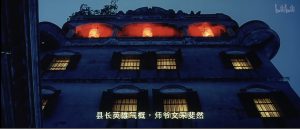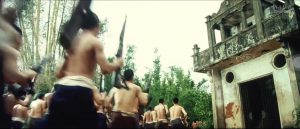Let the Bullets Fly , DIR. Jiang Wen (2010)
Kaiping Diaolou, Jiangmen , Guangdong, China

Kaiping Diaolou cluster in Jiangmen
Let the Bullets Fly is a 2010 Chinese action comedy film directed by Jiang Wen. The story starts with a bandit named Zhang Mazi, who impersonated official Ma Bangde to assume the position of county governor in Goose City. Out of a sense of justice, he fought with the local mobster boss, Master Huang, to protect the people’s safety. The film’s main plot was shot in the Kaiping Diaolou Cluster in Jiangmen, Guangdong, China.
Kaiping Diaolou was built by local overseas Chinese to protect the lives and property of their relatives in their hometown in the late 19th century and early 20th century. It integrates the Chinese traditional rural architectural culture with the western architectural culture, reflecting the cultural interaction between Chinese immigrant culture and different ethnic groups around the world. The most distinctive feature of these buildings is the decorative art on the top, including Chinese hard peak style, garden villa style, church style, ancient Roman style and Russian style. Therefore, Diaolou is very consistent with the era background of the Northern Warlords in the film when warlords separated and the world was in dispute. Diaolou is an essential character in this movie to promote the development of the plot. It plays the role of the cultural carrier in the film. Through its historical connotation, the director can lead the audience into the historical time and space to look for the past years on this land.Most of the people here have moved to the urban area, leaving some elderly people who are too old to stick here. And due to the publicity of the film, it has gradually become a tourist attraction.
In this film, Huang’s citadel is located in the Kaiping Diaolou cluster. It is the most magnificent one named Mingshi Lou(1925). This is a six-story building built by overseas Chinese businessmen Fang Runwen. On the sixth floor in the middle of the platform is a hexagonal pavilion, which artfully integrates Ionic Orders and the traditional Chinese glazed roof. The view here is the best, and the whole village’s rural scenery is at a glance. This pavilion repeatedly appeared in the film. When Zhang entered the Goose City, Huang stood here and “peeped” with a telescope. This fully utilized and reproduced the defense function of this building. This building also fits Huang’s background perfectly, as he is a wealthy man with a returnee background.
At the end of the film, people thought that the bully had been eliminated, so they were no longer afraid and rushed to Huang’s residence with guns. Huang’s subordinate Champion Wu betrayed him and even ran in front of others. It can be seen that “tyranny” is unpopular. Finally, after the last conversation with Zhang in front of the blockhouse, Huang was blown up together with his citadel.
— Chan Hiu Yu, 3035784162


- Mingshi Lou’s appearance and its top floor

The magnificent appearance of Huang‘s residence seen by Zhang when he went to the Hongmen banquet. Scenes from Let the bullets Fly 2010, directed by Jiang Wen

After Huang was defeated, people rushed into his citadel. Scenes from Let the Bullets Fly 2010, directed by Jiang Wen.
Notes:
1 In 2007, UNESCO listed Kaiping Diaolou as a world heritage site, Which is china’s first world heritage project of overseas Chinese culture.
2 History of Diaolou. https://en.wikipedia.org/wiki/Diaolou
3 Let the Bullets Fly. https://en.wikipedia.org/wiki/Let_the_Bullets_Fly
There is detailed background research on Kaiping Diaolou in terms of its construction and historical connotation. However, I would suggest a more engaging investigation through the lens of cinema. There are multiple relevant questions worth examining, for example, how did Kaiping Diaolou perform differently in the film compared with the real building? How did Dir Jiang capture the Kaiping Diaolou (including shooting techniques, color, lighting, film-set design, etc.)? How was the Kaiping Diaolou blown up at the end of the movie filmed to highlight Huang’s tragedy? Besides, expanding your reflection on the role that Kaiping Diaolou played in the movie based on the ideas/concepts/theories of coursework will strengthen your essay intelligently.